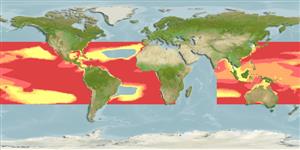Common names from other countries
Классификация / Names
народные названия | синонимы | Catalog of Fishes(род, виды) | ITIS | CoL | WoRMS | Cloffa
>
Scombriformes (Mackerels) >
Caristiidae (Manefishes)
Etymology: Paracaristius: Name from the Greek 'para' meaning around or near and Caristius.; nudarcus: Name from Latin adjective nudus meaning 'bare' or 'naked' and the noun arcus for arch, referring to the absence of fingerlike papillae on the dorsal surface of the hyoid arch (Ref. 87954).
Environment: milieu / climate zone / depth range / distribution range
экология
морской; пределы глубины 1 - 1800 m (Ref. 87954). Tropical; 40°N - 35°S (Ref. 87954)
Pacific, Indian and Atlantic Ocean: specimens were collected from the eastern and western Pacific Ocean, as well as the southern Indian and tropical Atlantic oceans.
Size / Вес / Возраст
Maturity: Lm ? range ? - ? cm
Max length : 22.3 cm SL самец/пол неопределен; (Ref. 87954)
Краткое описание
определительные ключи | морфология | морфометрия
членистые (мягкие) лучи спинного плавника (общее число) : 27 - 31; членистые (мягкие) лучи анального плавника: 17 - 20; позвонки: 33 - 37. This species is distinguished from P. nemorosus and P. aquilus by the absence of fingerlike papillae along the dorsal margin of the hyoid arch and at the interhyal-posterior ceratohyal articulation and by having fewer dorsal-fin rays, 27-31 (vs. 30-33 in P. nemorosus and P. aquilus); has more anal-fin rays, 17-20 (vs. 15-18); differs from P. maderensis by the position of the dorsal-fin origin which is above orbit (vs. posterior to orbit in P. maderensis), single row arrangement of the jaw teeth except near symphyses (vs. multiple rows in P. maderensis) (Ref. 87954).
Life cycle and mating behavior
Maturities | размножение | Spawnings | Egg(s) | Fecundities | личинки
Stevenson, D.E. and C.P. Kenaley, 2011. Revision of the manefish genus Paracaristius (Teleostei: Percomorpha: Caristiidae), with descriptions of a new genus and three new species. Copeia 2011(3):385-399 (Ref. 87954)
Статус Красного Списка МСОП (Ref. 130435)
CITES (Ref. 128078)
Not Evaluated
Угроза для людей
Harmless
Использование человеком
дополнительная информация
инструменты
Специальные отчеты
Скачать в формате XML
ресурсы в Интернет
Estimates based on models
Preferred temperature (Ref.
115969): 5.3 - 15.6, mean 9.4 (based on 978 cells).
Phylogenetic diversity index (Ref.
82804): PD
50 = 0.5625 [Uniqueness, from 0.5 = low to 2.0 = high].
Bayesian length-weight: a=0.01995 (0.00906 - 0.04395), b=3.01 (2.83 - 3.19), in cm Total Length, based on all LWR estimates for this body shape (Ref.
93245).
Trophic level (Ref.
69278): 3.6 ±0.5 se; based on size and trophs of closest relatives
Fishing Vulnerability (Ref.
59153): Low vulnerability (17 of 100).
